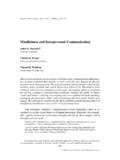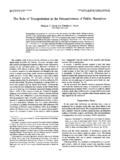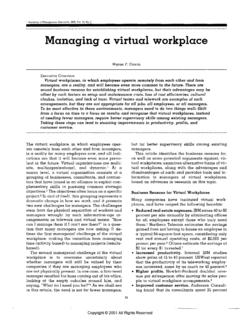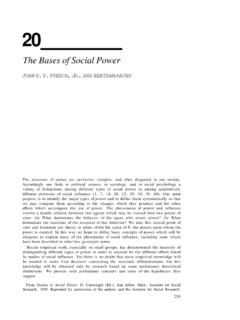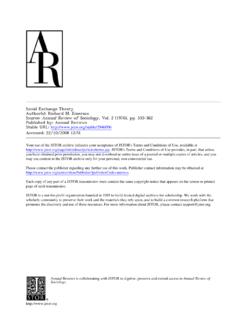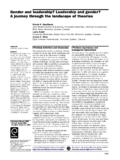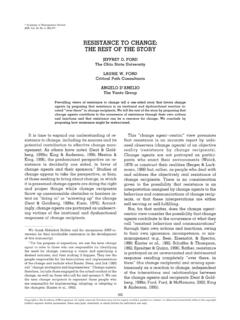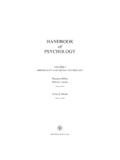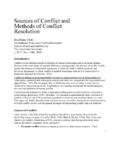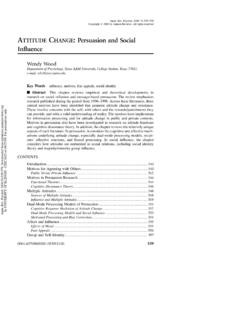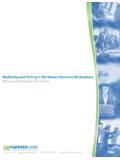Transcription of Influence Tactics and Objectives in Upward, …
1 Journal of Applied Psychology1990, Vol. 75. No. 2, 132-140 Copyright 1990 by the American Psychological Association, Tactics and Objectives in Upward, Downward,and Lateral Influence AttemptsGary Yukl and Cecilia M. FalbeManagement DepartmentState University of New \fork at AlbanyTwo studies were conducted to replicate and extend previous exploratory research by Kipnis,Schmidt, and Wilkinson (1980) on Influence Tactics and Objectives in organizations. A new question-naire was developed that included measures of important Influence Tactics and Objectives omitted inthe earlier research.
2 Whereas the earlier research used only agent self-reports of Influence behavior,the present research used both agent and target reports. Differences in downward, lateral, and up-ward Influence attempts were replicated more for data from agents than for data from targets. Direc-tion of Influence had a stronger effect on Influence Objectives than on Influence Tactics . Despite somedifferences due to data source and direction of Influence , the relative frequency of use for the 8influence Tactics was remarkably similar across conditions. Consultation and rational persuasionwere the Tactics used most frequently, regardless of the direction of of the most important determinants of managerialeffectiveness is success in influencing subordinates, peers, andsuperiors.
3 Despite the obvious importance of this subject, therehas been very little empirical research on the Influence behaviorof managers. Considerable research has been conducted onsources of managerial power (see Podsakoff & Schriesheim,1985), but only a few studies have examined issues such as thetypes of Influence Tactics used by managers and the Objectives oftheir Influence attempts (Kipnis, Schmidt, & Wilkinson, 1980;Mowday, 1978; Schilit & Locke, 1982).In the exploratory study by Kipnis et al. (1980), a question-naire was developed to measure categories of Influence behavior(called Influence Tactics ) and common reasons for making in-fluence attempts in organizations (called Influence Objectives ).
4 The questionnaire was administered to a sample of night stu-dents, and each respondent described how often he or she usedthe Influence Tactics in Influence attempts with a particular sub-ordinate, peer, or superior. On the basis of the results of theirexploratory research, Kipnis et al. concluded that managerstend to use different Tactics and to have somewhat different ob-jectives depending on the direction of Influence . This study wasan important first step but, like all exploratory research, thefindings need to be verified and the potential limitations exam-ined. Up until now the conclusions have been reported in manytextbooks as established facts about Influence Tactics in organi-zations rather than as tentative findings from a single explor-atory study.
5 Moreover, subsequent studies have used the influ-ence questionnaire to examine other types of research questions(Ansari & Kapoor, 1987; Erez& Rim, 1982) and as the basis fordeveloping a typology of managers based on patterns of Tactics (Kipnis & Schmidt, 1988).There are a number of limitations and potential problems inthe Kipnis et al. study. First, the items in their questionnaireCorrespondence concerning this article should be addressed to GaryYukl, Management Department, School of Business, SUNY, Albany,New York based on examples described by students, and the range ofinfluence Tactics measured by the questionnaire is too questionnaire does not include some Influence tacticsfound to be relevant for leadership effectiveness.
6 Second, theirlist of Influence Objectives needs to be extended to include oth-ers central to managerial work. Third, the research examinedonly self-perception of Influence Tactics and Objectives . The pos-sibility of systematic biases in these self-reports has not beenexamined. For example, respondents may have exaggeratedtheir use of socially desirable Influence Tactics , such as rationalpersuasion, and understated their use of less acceptable Tactics ,such as coercive pressure. Likewise, respondents may have beenbiased to select as their target someone toward whom they weremore likely to use socially desirable Influence present research had the following two major Objectives :(a) to determine if the major findings in the Kipnis et al.
7 Studycould be replicated with differences in methodology, and (b) toextend the research to include additional types of Influence be-havior and Objectives . This article describes preliminary re-search to develop new measures and two studies designed toaddress the potential limitations in the earlier research byKipnis et of the MeasuresInfluence TacticsPreliminary research was conducted to pretest and refine amore comprehensive questionnaire for measuring influencetactics. All of the items in our questionnaire were new, but in-cluded among them were items representing six of the eightscales in the Kipnis et al.
8 Study: assertiveness, rationality, ingra-tiation, exchange, upward appeals, and coalitions. Two of theirscales ("sanctions" and "blocking") were not represented in ourquestionnaire because of conceptual problems and infrequentuse. Most of their sanctions items ( , giving a pay increaseor promotion, suspending or firing the target) are reactions tosomething the target has already done rather than specific, pro-132 Influence Tactics AND OBJECTIVES133active Influence attempts. In their study, sanctions were usedinfrequently with subordinates (the mean item score in theirstudy was on a scale of 1 to 5) and not at all with peers orsuperiors (the mean item score was ).
9 Their blocking tacticwas used infrequently with coworkers (mean item score was )and almost never with superiors and subordinates (mean itemscores were ). The three blocking items with highest factorloadings appear to be examples of pressure Tactics (threaten tostop working with the person, engage in work slowdown,threaten to notify an outside agency). In their more recent re-search, Kipnis and his associates (Kipnis & Schmidt, 1988) nolonger include blocking as one of their Influence Tactics . Thus,there seemed little point to include either sanctions or blockingwhen the questionnaire space could be devoted to more relevantinfluence new questionnaire included items representing two in-fluence Tactics not found in the Kipnis et al.
10 Questionnaire butlikely to be important, namely, inspirational appeals and con-sultation. The major source of behavior examples for items rep-resenting these Tactics was the literature on managerial leader-ship. Inspirational appeals to values and emotions are an im-portant aspect of charismatic and transformational leadership(Bass, 1985;Bennis&Nanus, 1985; Conger &Kanungo, 1988;House, 1977; Tichy & Devanna, 1986). Inspirational appealsinclude (a) use of emotional, symbolic language to emphasizethe importance of a new project or task, (b) appeals to the targetperson's sense of justice, humanitarianism, or organizationalloyalty, and (c)
